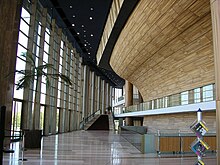Müpa Budapest
Müpa Budapest (the former Palace of Arts , Hungarian Művészetek Palotája - MÜPA ) is a cultural institution in Budapest .
The building offers space for three types of art: music , visual arts and theater . The exhibition rooms , the concert hall and the theater hall function independently of each other.
Location and construction
The building is located on the banks of the Danube on the Pest side of the Lágymányos Bridge , a formerly neglected urban area. The area of the Palace of the Arts takes up 10,000 m 2 of the 64,000 m 2 area where the National Theater is located. After three years of construction, the Palace of the Arts was opened on March 14, 2005.
The external appearance is characterized by simple lines, the lack of decorative elements and the mighty, coherent glass front. The spacious inner rooms are manageable. Natural materials were used for construction. The building design comes mainly from Gábor Zoboki ( Zoboki, Demeter és Társaik Építésziroda , "Architects Zoboki, Demeter and Co.").
The building units and their functions
The building offers the demands of modern art display possibilities in multifunctional rooms. It consists of three main wings. The central part is made up of the Bartók Béla Nemzeti Hangversenyterem ("National Béla Bartók Concert Hall"). The Fesztivál Színház ("Festival Theater") is located in the eastern wing . The west wing houses exhibition rooms and the event hall of the Ludwig Múzeum . The three building units are connected by the common glass facade, which opens up towards the National Theater.
The Palace of the Arts is the permanent seat of the Nemzeti Filharmonikus Zenekar, Énekkar és Kottatár (National Philharmonic Orchestra, Choir and Sheet Music Archive ), the Ludwig Múzeum and the Nemzeti Táncszínház ("National Dance Theater").
- The National Béla Bartók Concert Hall is the dominant part of the building from an architectural point of view. It offers space for 1699 visitors, of which 1563 are seated and 136 are standing. The acoustics and technical equipment correspond to the most modern concert halls in Europe. The acoustic elaboration was carried out by the US company Russell Johnsons. The organ was completed in 2006. It is a joint venture between Pécsi Orgonaépítő Kft. (“Pécser Orgelbauer GmbH”) and the German company Mühleisen . In addition to the Hungarian Philharmonic, other nationally and internationally important artists and orchestras also perform.
- The festival theater occupies the eastern wing. The stage area is 750 m 2 . The number of seats is 452. With its size and technical equipment, it is one of the most modern theaters and is the seat of the “National Dance Theater”.
- The Ludwig Kortárs Művészeti Múzeum ("Ludwig Museum of Contemporary Art") is located on the Danube side. The first floor is exhibition space. The presentation and event hall is also located in this wing. The permanent exhibition can be found in the bright rooms on the third floor. There are also interactive exhibition rooms, media corners, a library and childcare facilities for museum visitors.
The organization set up by the Nemzeti Kulturális Örökség Minisztériuma (“Ministry of National Cultural Heritage”) is responsible for organizing the program .
In 2006, the Palace of Arts won the FIABCI ( Nemzetközi Ingatlanszakmai Szövetség , “International Real Estate Company ”) Prix d'Excellence in the “Large Public Building” category. The plaque of the award is in the vestibule.
financing
The Palace of the Arts is the first public-private partnership construction in Hungary. The contract signed between the Viktor Orbán government and the TriGránit group associated with the name Sándor Démján , currently Hungary's richest entrepreneur, was negotiated in December 2001 and signed in March 2002. This provided that the private company would provide the costs of 31.2 billion forints , which the government - partly in the form of leasing - should repay with interest within 10 years. The amount had to be corrected upwards in the same year. The government set an upper limit of 52 billion forints. In 2005 this amount was set at 97.9 billion forints under Minister István Hiller and the term was extended to 30 years so that the annual payments could be reduced. A government spokesman officially stated that the amount will again not be enough to fully cover the costs. The state audit office found in 2007 that the first government plans were not financially covered. No market studies, impact analyzes or cost comparisons were carried out.
| State support to the MŰPA in billions of forints | |||
|---|---|---|---|
| year | 2005 | 2006 | 2007 |
|
Financing of events |
2.8 | 2.2 | 2.4 |
|
Maintenance costs |
6.2 | 8.9 | 8.8 |
| total | 9 | 11.1 | 11.2 |
| Framework for promoting culture | 59.8 | 54.4 |
- * excluding the support of the Philharmonic Orchestra, the Ludwig Museum and the dance theater
Web links
Homepage of the Palace of the Arts. Művészetek Palotája, accessed on November 20, 2008 (Hungarian, German, English).
Coordinates: 47 ° 28 ′ 10 ″ N , 19 ° 4 ′ 18 ″ E



